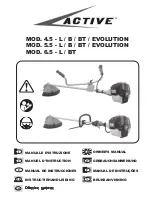
11
7.Keep ON/OFF switch depressed until end of the pipe is even with edge of the dies. Release the switch
button.
8. Back off the Die Head from the threaded pipe, reversing the directional switch and actuating the
ON/OFF switch.
Note! Hold onto the threader handle firmly to resist handle forces developed while backing off the
Die Head.
9.When dies clear the end of the pipe, grip the handle on top of the threader and remove the threader and
Die Head from the pipe.
10. Remove the support arm from the pipe.
Note! To avoid injury, make sure long sections of pipe are supported at the end farthest away from
the vise prior to removal.
Inspecting Threads
1. Remove any oil, chips or debris from the thread.
2. Visually inspect thread. Threads should be smooth and complete, with good form. If issues such as
thread tearing, thin threads, or pipe out-of-roundness are observed, the thread may not seal when made
up. Refer to the
“
Troubleshooting
”
chart for help in diagnosing these issues.
3. Inspect the size of the thread. The preferred method of checking thread size is with a ring gauge. There
are various styles of ring gauges, and their usage may differ from that shown in
Figure 7
.
•
Screw ring gauge onto the thread hand tight.
•
Look at how far the pipe end extends through the ring gauge. The end of the pipe should be flush with
the side of the gauge plus or minus one turn. If thread does not gauge properly, cut off the thread, adjust
the die head and cut another thread. Using a thread that does not gauge properly can cause leaks.
Fig 7
• If a ring gauge is not available to inspect thread size, it is possible to use a new clean fitting
representative of those used on the job to gauge thread size. For 2" and under NPT threads, the threads
should be cut to obtain 4 to 5 turns to hand tight engagement with the fitting and for 2" and under BSPT
threads it should be 3 turns.
Maintenance Instructions
Make sure machine is unplugged from power source before performing maintenance or making
































